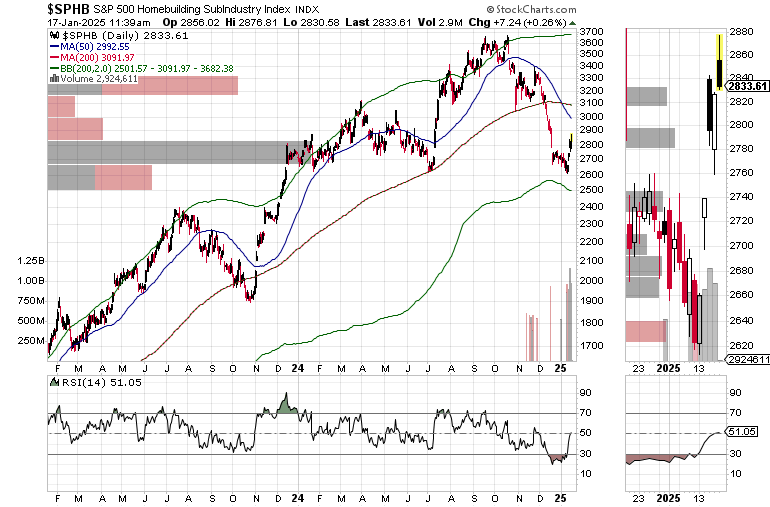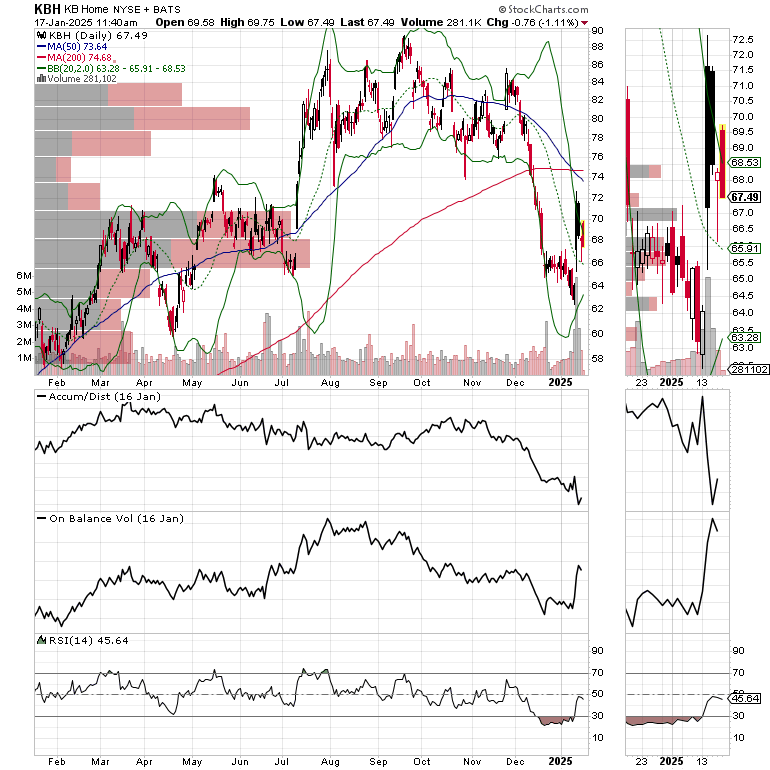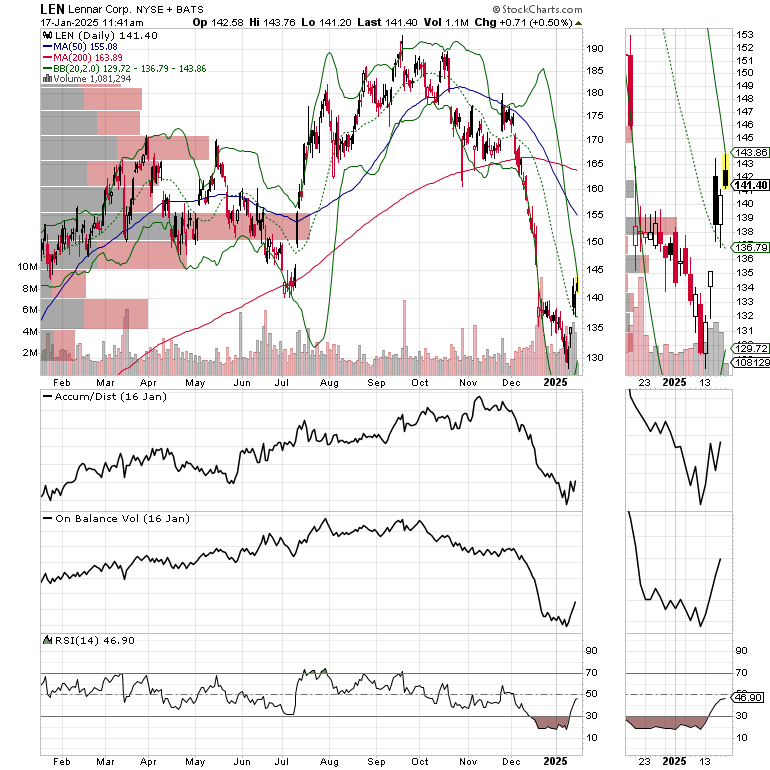What does the future hold?

The stock market seems to be in recovery mode as it jumped into reversal mode on 1/15/25 as the December CPI came in somewhat tamer than expected. The less bad than expected reading in CPI followed a lower than expected December PPI released on 1/14. Based on the numbers, the market has talked itself into a “things aren’t as bad as we thought rally.”
A great beneficiary of the rally have been the housing related stocks, in which I’ve been recommending building some positions over the last few weeks. I’ll have more on that just below. First, however, consider the following.
Back in October 2024 I wrote a piece on how Chaos Theory works. The short version is that seemingly unrelated events in faraway places can have precise and meaningful influences on events and situations in remote locations.
We are in one of those moments now.
Not So Fast – January’s Inflation Numbers May Tell a Different Story.
Even though the bull market in the homebuilder sector ended in 2024, I’m still all about the long term bullish supply and demand scenario for housing. And, until proven otherwise, after the recent washout we’ve likely seen the worst for the sector, with one caveat: a resurgence of inflation, such as what the California fires may engender. Thus, even though the short term looks favorable, things may change rapidly. Specifically, If we see a move in the U.S. Ten Year Note yield (TNX) above 5%, and it sticks, we’re in a whole new ballgame.
And what could send TNX above 5%. How about a huge inflation surprise in January’s price report?
Certainly, there are some extraordinary events unfolding, especially in the wake of the California fires where large numbers of people are suddenly homeless and their ability to recoup their costs – even partially – without some sort of federal bailout is uncertain. That’s because of the poor insurance situation in the state. Already, there are reports that some landlords have increased rents by over 100% (90% above the state mandated limit of 10%).
Indeed, the most stubborn area of CPI over the last year has been rent. Yet, there are signs that these fires may already be affecting other areas of consumer prices, which could well show up in the January producer and consumer price data. This week, I went to Costco and here’s what I saw:
• Avocados - $9.99 for 6 ($5.99 in July 2024)
• Ribeye steaks – four large ones - $80 ($56.52 in July 2024 - $70 just last week)
• Organic Eggs – Two Dozen - $7.49 ($6.99 in July 2024)
• Organic Blackberry – single pack - $7.69 ($5.69 in July 2024).
Those four items cost $75.89 in July 2024. In January 2025, they cost $105.17. That’s a 38.58% price increase. Let that sink in for a while as you factor in the potential price increases that will likely work their way through the supply chain, especially when you try to eat at a restaurant.
There are reports of the cattle herd in the U.S. being reduced. But, even a week earlier, the same steaks were selling for $70. So, I can’t explain why the prices, especially for steaks have suddenly exploded, especially $20 for steaks that were selling at an already well above the prices they were a few months ago in the past two weeks, other than the California fires and the potential for supply chain issues developing rapidly. Add that to the likely rent increases that are likely in the pipeline for anyone who is about to renew their lease, especially in Southern California, Nevada, Arizona, and Texas where we may see a further increase in population as people make decisions about their futures.
The Housing Rally – Earnings and Interest Rates Will Decide What’s Next
The homebuilders and to a certain degree real estate investment trusts which specialize in residential properties have an advantage because the post pandemic shift to suburbs, the sun-belt and more rural locations changed the dynamics of a housing market. The result has been a tightening of housing supplies in more desirable locations.
More recently, the rise in bond yields and the accompanying climb in mortgage rates led to a slight pullback in revenues and earnings for many homebuilders which prompted them to pull back their horns and issue less than enthusiastic guidance. This led to a bloodbath in the homebuilder stocks, which can be appreciated in the price chart for the S&P 500 Homebuilding Subindustry Index (SPHB), which lost nearly 30% of its value from its top in October 2024 until it recently bottomed in early 2025. Much of the decline was directly due to the rise in the U.S. Ten Year Note yield (TNX), and the subsequent rise in mortgage rates.

Aside from the clearly oversold status of the index, the rally was sparked by a rally in homebuilder KBH, which, on 1/14/25 reported much better than expected earnings, including better margins and guidance than some of its peers had offered in the prior quarter. However, KBH has been giving back some of its gains lately, which means it’s a good idea to keep an eye on things.

We’ll see if other homebuilders can deliver equally bullish news in the next couple of weeks. Sector bellwethers Lennar (LEN) and D.R. Horton (DHI) both report on 1/21/25. Lennar’s earnings expectations have been revised lower by 17 analysts while Horton’s expectations have been pared back by 16 analysts. If they’re wrong, and both beat the already lowered expectations, we may see an extension of the rally. For context, prior to the earnings, KBH’s estimates had been lowered by nine analysts.

Bonds, Bonds, Bonds
A lot is riding on what happens in the bond market. The U.S. Ten Year Note yield (TNX) holds the key with the 4.6% yield area providing important short term resistance. A move above 4.75% will likely escalate and we may see a test of 5%. Needless to say that would be a big negative for homebuilders and likely the rest of the stock market .
Bottom Line
The long term for the housing market remains bullish for homebuilders and residential REITs. But their success depends on interest rates.
Higher bond yields will be negative for this sector.
There are many unanswered questions about inflation and the effects of the California fires. Rest assured that their effect will be felt throughout the economy.
Thanks to everyone for your ongoing support. I really appreciate it.
Thanks also to all the current Buy Me a Coffee members and supporters. Special shout out to new members who now have access to the Sector Selector ETF Service, included, at no extra charge with your Buy Me a Coffee membership. Two new trades were posted yesterday.
For active trading, short term trading strategies, check out the Smart Money Passport.
For large potential profits with longer term holding periods in stocks check out the Smart Money Passport Weekender Portfolio.
I also appreciate single coffees, which you can buy me here.
If you’re thinking about day trading, my new book – Day Trading 101
– will get you started along the right path.
Trading is stressful and can drag you down. You can feel better if you take the right supplements. Check out our health page.
And if you like this post, hit the Like Button and Share/Restack it. It helps to spread the word.
